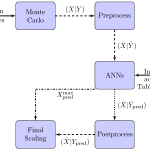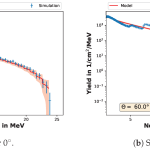Eckdaten
- Zeit: 01/2019 – 03/2023
- An der TU Darmstadt, TEMF, Prof. Boine-Frankenheim
- Teil der Forschung zur Dissertation
- Fokus:
- Monte Carlo Simulation (mit PHITS)
- Hochleistungsrechnen (auf Windowscluster)
- KI gestütze Modellierung (mit Keras und Tensorflow)
Ergebnisse
Dieses Projekt resultierte in mehreren Publikationen:
- Datenrepository zur Modellierung Neutronen Yields
- KI Modell zur Vorhersage und Optimierung
- Ein peer-reviewed Artikel
BESCHREIBUNG
Das Ziel dieses Projektes ist das Finden eines Surrogatmodels für doppelt differentielle Neutronen Yields.
Basierend auf einem extensiven Simulationsdatensatz wurde ein Surrogatmodel basierend auf Künstlichen Neuronalen Netzen entwickelt. Während die Simulationen gewisse Bereiche gut abbilden kann, kann es nicht in Bereiche extrapolieren die nicht im Rahmen der Simulationen getestet wurden.
Es ist wichtig zu verstehen, dass die Spektren komplexes Verhalten an den Tag legen aber . durch eine Aufteilung der Modellierung viel gewonnen werden kann.
Daher wurden 2 Modelle trainiert welche zusammen notwendig sind um ein volles Spektrum vorherzusagen.
Beide Modelle und detaillierte Informationen sind hier verlinkt.
Das aktuelle Model ist nutzbar, kann aber mit neuen Daten weiter verbessert werden.
META
- Time: 01/2019 – 03/2023
- At TU Darmstadt, TEMF, Prof. Boine-Frankenheim
- Part of my PhD research
- Focus:
- Monte Carlo Simulations (with PHITS)
- High Performance Computing (using a Windowscluster)
- AI supported modeling (using Keras and Tensorflow)
DEliverables
The project resultet in several deliverables:
- Datarepsitory for the modelling of double differential neutron yields.
- AI model for the prediction and optimization of experimental parameters
- One peer reviewed article
Description
This project aims to determine a surrogate model for double differential neutron yields.
Based on an extensive simulation dataset, a surrogate model based on artificial neural networks was developed. While the simulations can represent certain areas well, it cannot extrapolate to areas that were not tested in the simulations.
It is important to understand that the spectra exhibit complex behavior but much can be gained by splitting the modeling.
Therefore 2 models were trained which together are necessary to predict a full spectrum.
Both models and detailed information are linked here.
The model at the current state is usable, but if further data is generated it might still be improved by extensive retraining.
- B. Schmitz
Neutron Yield Spectra simulated with Monte Carlo code
Corresponding Gitlab B. Schmitz
Modeling a Neutron Yield Model
Corresponding GitlabB. Schmitz, S. Scheuren
Neutron Yield Predictions with Artificial Neural Networks: A Predictive Modeling Approach
J. Nucl. Eng. 2024, 5(2), 114-127



